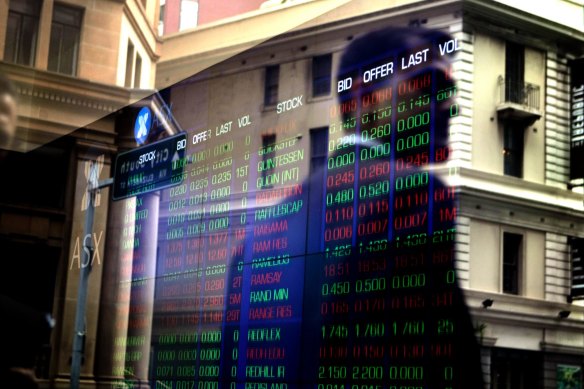ASX opens tentatively higher as market awaits key data
By Millie Muroi
The Australian sharemarket crept higher on Wednesday morning, buoyed by the materials sector, amid flatter terrain in global markets which are stuck in a holding pattern ahead of the release of US inflation data this week.
The S&P/ASX 200 was up 54 points, or 0.76 per cent, to 7185, about midday, surpassing expectations of a 6 point, or 0.08 per cent, rise, to 7106 points as indicated by ASX futures at 7.35am.

Lithium and borax producer Allkem and minerals mining company IGO were the top lifters at midday, gaining 5.5 and 4.1 per cent.
The information technology sector weighed down the index, as technology company Xero shed 5.9 per cent, while most other sectors traded flat.
ABS data released on Wednesday showed that Australia’s monthly inflation index came in a touch higher than expected. Headline inflation landed at 7.3 per cent, while trimmed mean inflation was 5.6 per cent, compared with expectations of 5.5 per cent.
Meanwhile, job vacancies have declined 4.9 per cent from August, driven by healthcare and social assistance, but remain about 95 per cent higher than they were before the pandemic.
Overnight on Wall Street, stocks began to drift higher after being largely flat during the trading session.
The next big marker for the market is Thursday’s update on how bad inflation was last month at the consumer level.
The S&P 500 was 0.5 per cent higher in afternoon trading after flipping between small gains and losses through the day. The Dow Jones Industrial Average was up 96 points, or 0.3 per cent, at 33,614, in mid-afternoon trade in New York, and the Nasdaq composite was 0.7 per cent higher.
The stock market has had a positive start to 2023 due to hopes that cooling inflation and a slowing economy may convince the Federal Reserve to ease off its markets-shaking rises to interest rates earlier. The Fed since early last year has been raising rates at a furious pace in hopes of getting the nation’s painful inflation under control. Such moves risk causing a recession and drag on prices for investments.
Investors were hoping for some clues about where the Fed is heading from its chair, Jerome Powell, who made remarks at a forum in Stockholm on Tuesday. But he gave little news about rates.
The next big marker for the market is Thursday’s update on how bad inflation was last month at the consumer level. Economists expect it to show US inflation slowed further to 6.5 per cent from 7.1 per cent in November and from a peak of more than 9 per cent in the summer.
A worse-than-expected reading could dash the building hopes on Wall Street that the Fed may stop its rises soon and perhaps even cut rates by the end of the year. Some investors see the economy successfully walking the tightrope of slowing enough to kill off high inflation but not so much as to cause a painful recession.
Past rate increases and high inflation have already hurt economic activity around the world, and the Fed has pledged to keep rates high for a while to ensure the job is done on inflation. It doesn’t envision any rate cuts until 2024.
The World Bank said in its annual report on Tuesday the global economy would come perilously close to a recession this year.
It usually takes a while for rate rises to be fully felt in the economy. That could push a recession off to the second half of the year, said Barry Bannister, chief equity strategist at Stifel. The global economy could also benefit from strengthening in China, as it removes restrictions meant to keep COVID-19 at bay but that also hurt its economy.
“You’re looking at a pretty good six months where things get better at the margins and then trouble starts to rear its head,” Bannister said.
Meanwhile, big US companies later this week will begin showing investors how much profit they made during the last three months of 2022. Hot inflation has been squeezing customers’ wallets and raising costs for businesses, threatening their earnings.
Macy’s and several businesses have already given warnings about their results for the fourth quarter of 2022 and into 2023.
Troubled home goods retailer Bed Bath & Beyond on Tuesday reported weaker revenue for its latest quarter than analysts expected, though the size of its loss wasn’t as bad as Wall Street forecast. Its stock rose 21 per cent after it also announced more cost cuts as it tries to survive.
Job cuts are also continuing in tech-oriented companies, a notable soft spot in what’s otherwise been a healthy US job market. The continuing collapse for crypto pushed Coinbase to say it’s laying off 20 per cent of its workforce. The stock rose 9.2 per cent.
Bond yields rose. The yield on the 10-year Treasury, which helps set mortgage rates, climbed to 3.61 per cent from 3.53 per cent late Monday.
With AP
Most Viewed in Business
Source: Thanks smh.com